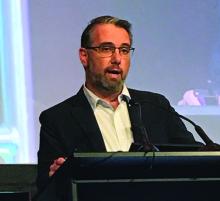WEST PALM BEACH, FLORIDA — , according to a summary of the science as well as a late-breaker study presented at the annual meeting held by the Americas Committee for Treatment and Research in Multiple Sclerosis (ACTRIMS).
In an outline of barriers to remyelinating drugs, including the challenge of delivering well-tolerated therapies into the central nervous system (CNS), Ari J. Green, MD, Chief of the Division of Neuroimmunology and Glial Biology, University of California, San Francisco, spoke specifically about recent progress in drug development.
“The important thing is that once we understand the biology, we can turn barriers into opportunities,” he said as he outlined advances over the 6 years since he led the ReBUILD trial.
“We are thinking of remyelination therapies as something off in the horizon,” said Dr. Green, but “the horizon might be closer than we might imagine.”
The double-blind ReBUILD trial provided the first evidence of activity from a remyelinating drug. In this study, 50 patients with chronic demyelinating optic neuropathy and relapsing-remitting MS were randomized to twice daily doses (5-36 mg) of clemastine fumarate for 90 days followed by placebo for 60 days or to placebo for 60 days followed by active drug for 90 days.
Remyelinating Effect Documented at Multiple Sites
The improvement on the primary endpoint of visual evoked potentials was interpreted as evidence that the therapy had a positive remyelinating effect, and Dr. Green said that the result has been reproduced by more than a dozen other centers.
The theoretical benefit is from a favorable effect on myelin-producing stem cells, but Dr. Green emphasized that theoretical benefits are not enough for moving the field forward. Negative trials with a theoretical potential to generate remyelination both preceded and followed ReBUILD. Examples include the RENEW study with the anti-lingo monoclonal antibody opicinumab and the CCMR One study with the non-selective retinoid X receptor agonist bexarotene.
Whether there is benefit or failure, “we need to be able to tell what is going on,” Dr. Green said. The reason is that a negative result is not necessarily due to the absence of a meaningful remyelination. Rather, other variables, such as an insufficient number of axons to remyelinate, might explain a lack of effect.
Citing evidence that remyelination and demyelination are often concurrent events, Dr. Green said that there is an urgent need for tools to objectively quantify myelination in order to document that drugs purported to favorably influence myelin repair are doing so. Surrogate markers are potentially unreliable.
“There is an unfortunate tendency in our field to overinterpret atrophy and neurodegeneration and to use those terms too loosely,” Dr. Green said. He said these terms are not interchangeable.
One basis for excitement is the growing support for the theory that oligodendrocyte progenitor cell (OPC) recruitment is critical to the remyelination process. By activating these cells or blocking inhibitors of their activity, experimental evidence suggests new myelin formation can occur. However, a clinically meaningful benefit might still be dependent on multiple additional factors, including the timing of OPC recruitment, Dr. Green explained.
“We might need to provide drugs with a remyelinating effect very early in the process,” he said.
The progress in understanding the interacting factors that define the biology of remyelination is the basis for new enthusiasm about this field, agreed Véronique Miron, PhD, Chair of the Multiple Sclerosis Research, Barlo MS Center, Toronto. Dr. Miron, professor in the Department of Immunology at the University of Toronto, identified the session on remyelination in which Dr. Green spoke as one of the highlights of this year’s ACTRIMS conference.


